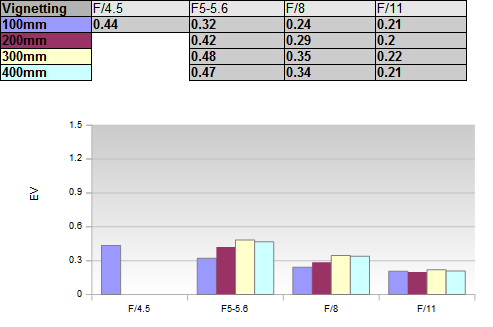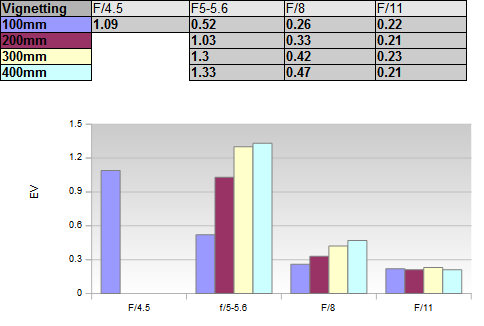|
Fujinon XF 100-400mm f/4.5-5.6 R LM OIS WR - Review / Test - Analysis |
|
Lens Reviews -
Fujifilm X
|
|
Page 2 of 3

Distortion
Fujifilm relies on image auto-correction so users don't need to worry about image distortions when sticking to default settings.
However, it's always interesting to look behind the scene. The original characteristic of the lens is clearly worse. Interestingly the lens shows pincushion distortions at all tested settings which is a quite unique characteristic. The figures are comparatively high with up to 2% distortions.
If you move your mouse cursor over the image you can switch to the corresponding raw/native results (there may be a short delay).
Vignetting
Image auto-correction is also active for compensating vignetting.
Thus the figures are very moderate even at fully open aperture with a maximum light falloff around the 0.5EV (f-stop) mark.
 In RAW mode - thus with disabled vignetting- and distortion-correction, the results aren't all that impressive anymore.
The light falloff is clearly visible at max. aperture with a maximum of 1.3EV at the long end. Closing the aperture by 1 f-stop reduces the light falloff to fairly negligible levels though.
In RAW mode - thus with disabled vignetting- and distortion-correction, the results aren't all that impressive anymore.
The light falloff is clearly visible at max. aperture with a maximum of 1.3EV at the long end. Closing the aperture by 1 f-stop reduces the light falloff to fairly negligible levels though.
 Please note that vignetting compensation is also a lossy procedure because it increases the corner (sensor-)noise.
Please note that vignetting compensation is also a lossy procedure because it increases the corner (sensor-)noise.
MTF (resolution)
Remember that this is a chart-based MTF system and the longer the focal length, the longer the distance between camera and chart. Beyond 300mm air diffusion is starting to have a higher impact and as you can conclude, it's getting correspondingly more pronounced the more you zoom out. Please keep that in mind here. The max aperture of f/4.5-5.6 is also slower than the "optimum" aperture of the Fujifilm system which is slightly below the f/4 mark (in practical terms).
Given the focal length range, the Fujinon XF 100-400mm f/4.5-5.6 R LM OIS WR delivered impressive resolution results in the MTF lab. The center performance is excellent both at 100mm f/4.5 and 200mm f/5. The borders are very good and the extreme corners are also sharp. Diffraction is has a slight impact at f/8 but f/11 remains usable (avoid f/16). At 300mm we are seeing a very slight decrease in quality. The center quality is still very good at 400mm whereas the border quality slips to good levels. The extreme corners are somewhat softer still albeit not bad (please remember what we mentioned in the info box above).
The field curvature is marginal. The centering quality of the tested sample was pretty good (better than usual for a Fujinon zoom lens).
Please note that the MTF results are not directly comparable across the different systems!
Below is a simplified summary of the formal findings. The chart shows line widths
per picture height (LW/PH) which can be taken as a measure for sharpness.
If you want to know more about the MTF50 figures you may check out the corresponding
Imatest Explanations
Chromatic Aberrations (CAs)
Fujinon lenses rarely disappoint us in terms of lateral CAs (color shadows at hard contrast transitions) and that's also valid for the Fujinon XF 100-400mm f/4.5-5.6 R LM OIS WR. While not perfect, the CA stay below 1px on the average at the image borders.

Bokeh
The Fujinon is a slow lens so unless you can select a comparatively short focus distance, the bokeh (rendering of the out-of-focus blur) will be relatively underdeveloped. That being said, the quality of the bokeh is quite impressive for such a lens. Below at two sample crops showing the general blur just before (right) and beyond (left) for the focus point. You can see that the edge transitions are very smooth.
 Out-of-focus highlights are relatively nicely rendered. The inner disc isn't perfectly "clean" and there's a bit of an outlining effect that is getting somewhat emphasized the more you stop down. However, this is better than on most super tele zoom lenses. You may also notice that the highlight discs remain pretty much circular even at f/11 which shows that the 9 rounded aperture blades have a positive effect here.
Out-of-focus highlights are relatively nicely rendered. The inner disc isn't perfectly "clean" and there's a bit of an outlining effect that is getting somewhat emphasized the more you stop down. However, this is better than on most super tele zoom lenses. You may also notice that the highlight discs remain pretty much circular even at f/11 which shows that the 9 rounded aperture blades have a positive effect here.
 The highlights aren't quite as harmonious towards the corners. As you can see below they deteriorate to "cat eyes" - this is a vignetting effect. However, this is quite normal and the issue can be reduced by stopping down.
The highlights aren't quite as harmonious towards the corners. As you can see below they deteriorate to "cat eyes" - this is a vignetting effect. However, this is quite normal and the issue can be reduced by stopping down.
 We didn't test bokeh fringing because the lens is just too slow for negative effects here.
We didn't test bokeh fringing because the lens is just too slow for negative effects here.
|